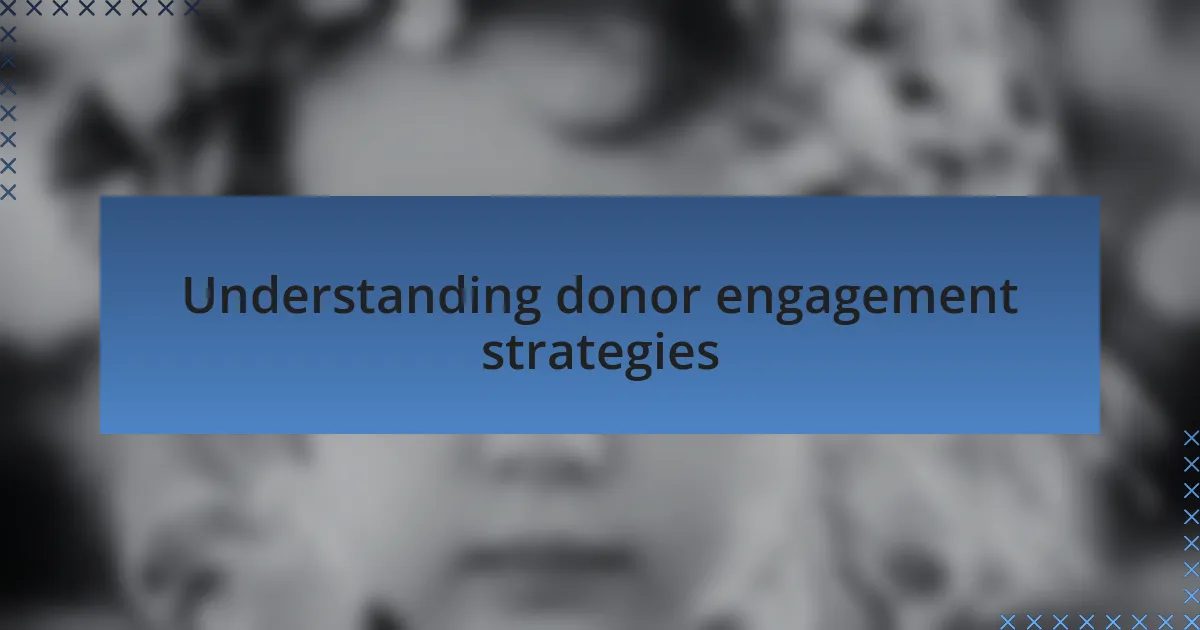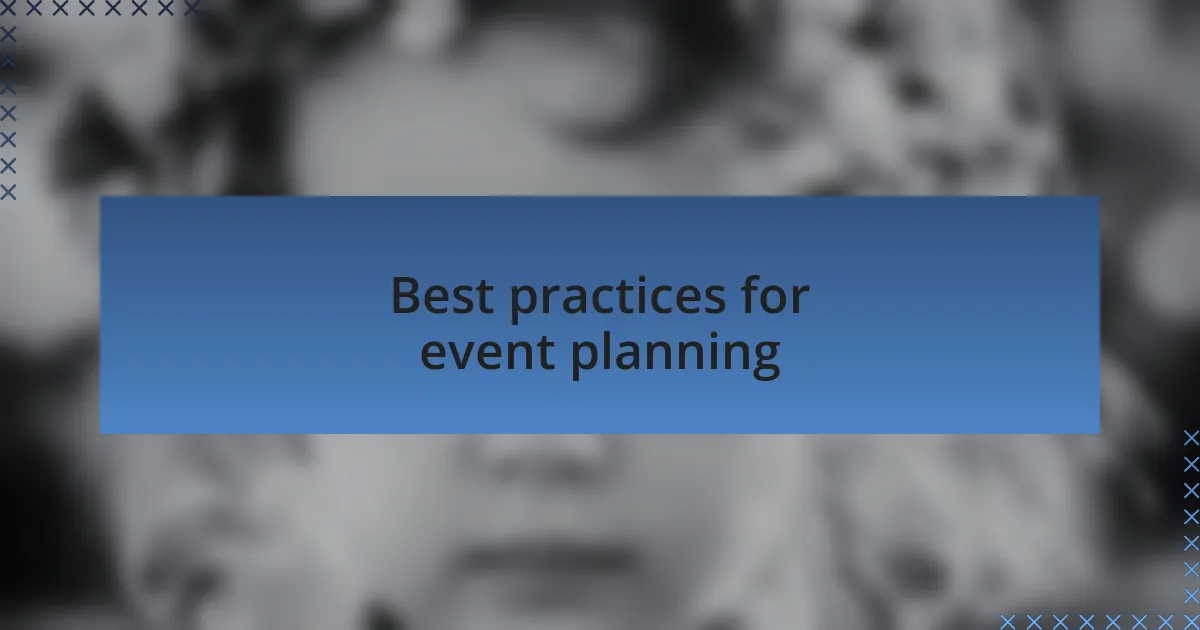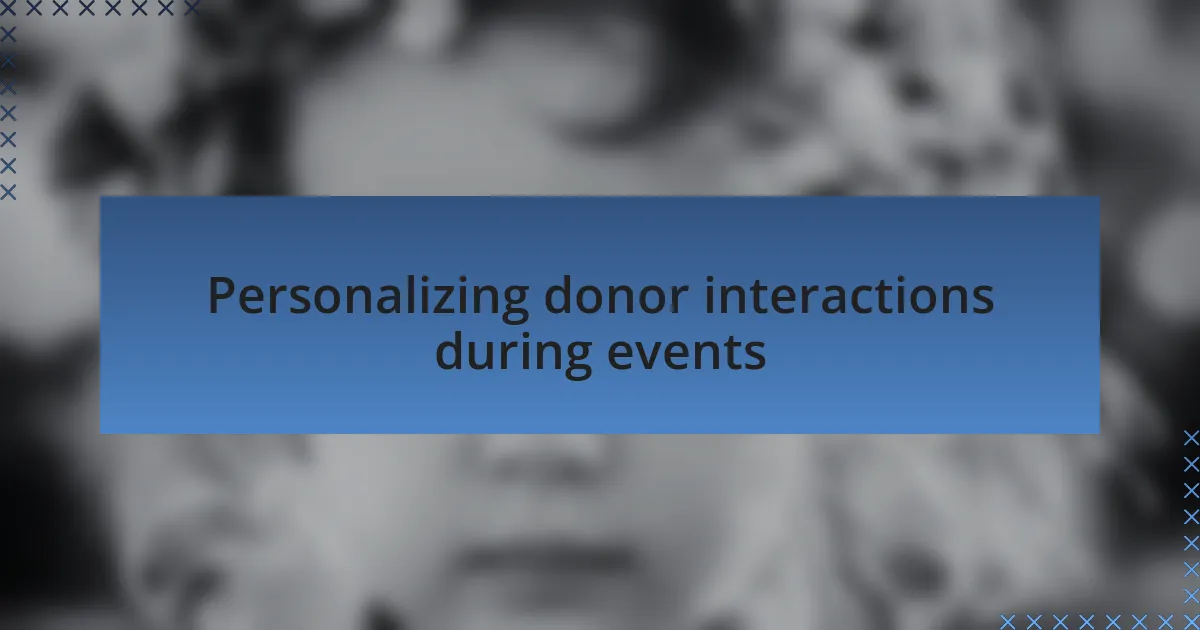Key takeaways:
- Personal personalized thank-you notes and follow-ups strengthen donor relationships and emphasize their importance to the mission.
- Cultivating emotional connections through storytelling and interactive elements enhances donor engagement during events.
- Custom gifts and personalized interactions create a lasting impact, making donors feel valued and appreciated.
- Clear communication before and after events fosters excitement and reinforces ongoing support from donors.

Understanding donor engagement strategies
Understanding donor engagement strategies is essential for building lasting relationships. I recall a recent event where we personalized thank-you notes to each donor, highlighting how their contributions directly impacted our mission. That simple gesture not only strengthened our bond but showed donors that they are valued partners in our cause.
Effective engagement goes beyond just asking for support; it’s about creating meaningful experiences. Have you ever considered how the atmosphere of an event can influence donor relations? At one memorable gala, we incorporated stories from children we’ve helped, allowing attendees to see the real-life outcomes of their generosity. It created an emotional connection that I believe significantly increased their willingness to give.
Furthermore, creating opportunities for donors to interact with beneficiaries can enhance their involvement. I remember organizing a casual picnic where donors could meet the families benefiting from their support. The joy and gratitude shared that day fostered a sense of community that made our donors feel more connected to our mission. These moments reinforce the idea that donor engagement is a continuous process of building trust and understanding.

Best practices for event planning
When planning an event, I’ve found that setting a clear purpose is crucial. Each detail needs to align with your mission. I once helped organize a fundraising run, and we carefully designed everything, from the logo to the music, to reflect the joy and hope we aimed to promote. It’s amazing how focusing on a singular theme can unify every aspect of the event.
One practice that stands out to me is the importance of communication leading up to the event. I’ve learned that keeping donors informed about what to expect not only builds excitement but also makes them feel included. A few weeks before a gala, I shared sneak peeks of the auction items and even fun facts about the beneficiaries. This transparency creates anticipation and reminds guests why they’re there—that connection is vital in fostering ongoing support.
Lastly, don’t underestimate the power of post-event follow-up. I remember reaching out to attendees a day after an event with personalized emails thanking them for their presence and participation. It’s a simple gesture, but it shows that you value them beyond just their donations. Have you ever considered how that small act can leave a lasting impression? I believe it reinforces the relationship and encourages donors to stay engaged.

Creating memorable event experiences
Creating memorable events hinges on the details that resonate on a personal level. At one charity gala, we decided to include stories from beneficiaries as part of the program. The moment a young girl shared her journey, you could feel the room shift. It created a deep emotional connection that lit up the atmosphere. Have you ever noticed how a heartfelt story can transform an event from merely attending to truly experiencing it?
Interactive elements can also elevate the engagement factor significantly. I once implemented a ‘Thank You’ wall where attendees could write messages to donors they felt inspired by. This not only encouraged interaction but also allowed guests to express gratitude in real-time, creating memories that linger long after the event is over. Wouldn’t you agree that fostering a sense of community makes everyone feel more invested?
Finally, consider the unique touch of personalized thank-you gifts. At an event where we provided handmade items crafted by children from our programs, the response was overwhelming. Each gift served as a tangible reminder of why we gathered that day. It’s incredible how such thoughtful gestures can create lasting impressions, sparking conversations and connections that extend beyond the event itself.

Personalizing donor interactions during events
Personalizing donor interactions during events is all about showing appreciation in ways that resonate deeply. I once partnered with a local artist to create custom art pieces for our top donors, featuring elements tied to their contributions. Watching their faces light up as they recognized familiar themes was a reminder that personal touches can forge unforgettable connections. Have you ever received a gift that felt uniquely tailored to you? Those moments stay with us far longer than generic acknowledgments.
Another strategy I’ve found effective is tailoring conversations based on the individual’s history with our charity. At a recent fundraising dinner, I made a point to chat with each guest about their past contributions and the specific impact they’ve had. When I shared updates on the children who benefited from their generosity, I could see the pride in their eyes. Isn’t it remarkable how acknowledging someone’s unique journey can amplify their sense of belonging in a philanthropic community?
I also believe in the power of names—simple, yet so impactful. During one event, I took extra care to remember and use the names of our donors throughout the evening. When I called out a donor’s name during a thank-you speech, their joy was palpable, and it sparked conversations among tables. It’s extraordinary how personal acknowledgment can transform a sea of faces into a network of valued supporters. Wouldn’t you agree that personal interactions can elevate a fundraiser from good to truly extraordinary?